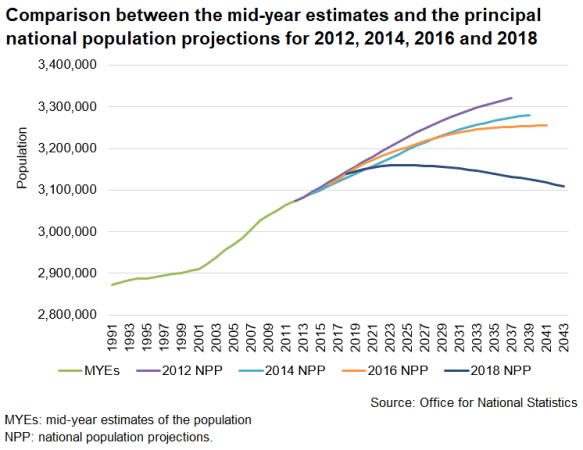Darllenwch y dudalen hon yn Cymraeg
Our local authority population projections are one of the most widely used sets of information that we produce. The projections look at what has been happening to the population in recent years and project it forward into the future. They are used to help a range of organisations plan for the future (for example to plan houses, schools, nurseries and social services), and are used to help distribute money too. They do not take account of any future political or economic developments (for example Brexit).
We have produced our own subnational projections (for local authorities and national parks in Wales) for more than 15 years. Since then we have provided updates around every three years or so. Our last set of projections, the 2014-based projections, were published in 2016.
On the 31 October we had planned to publish our latest set of subnational population projections (2017-based), however we have this week taken the decision to postpone them. This is because of new data published earlier this week and some issues raised during quality assurance of the projections that required further work to overcome.
We place great value in the accuracy of what we publish and it was important that we took stock of both those issues before publishing a new set of data that will inform decision making for years to come.
On Monday, the Office for National Statistics (ONS) published its 2018-based national population projections (for the UK and the four nations). For the first time in recent history the principal projection (which uses the most recent trends and projects them forward) shows a projected decline in the population in Wales over the longer term. The ONS has also published a blog about how the projections are based on past trends, and should not be seen as predictions.
The national population projections are a key input to the subnational projections. The 2017-based subnational projections were using some of the underlying data from the 2016-based national projections, and continuing to use those would mean that our subnational projections would be very different to the more recent national projections. The chart below shows the difference between the population mid-year estimates, the 2018-based national principal projection and previous national projections for Wales.

Further to this, following the publication of the 2014-based subnational projections in 2016 some concerns had been raised around how likely some of the results were over the longer term for a few local authorities. Having looked into these concerns, they are caused mostly by the migration assumptions in the projections. The projections have always assumed that the trends over the last few years for migration will not change in the future, which is similar to how other countries also calculate their projections. For example if 1,500 people leave a local authority in 2020 but 1,600 move in (so it gains 100) then that will also be the case in 2040, even if the population of that local authority has got larger or smaller.
The analysis of our emerging results from the refreshed projections that were due to be published on the 31 October show some results that are not plausible for some local authorities due to the migration assumptions, and we think that more work is needed to ensure we have a set of projections that are fit for purpose.
The subnational population projections are signed off by our technical advisory group – the Wales Subnational Projections group (WaSP). WaSP is a group of demographic experts from across local authorities and national park authorities in Wales. They are a valuable advisory group for us and have provided us with the challenge that we need to ensure the projections are robust, but also helped us when we have come across issues previously. They are supportive of the postponement of these statistics.
We are aware that we have already postponed these projections from August to the end of October and that many of our users want to have this data as soon as is possible.
On the 31 October we will publish a short report providing some more detail around the issues described above.
A new date for the projections will be announced as soon as we can.
Glyn Jones
Chief Statistician
Email: stats.popcensus@gov.wales